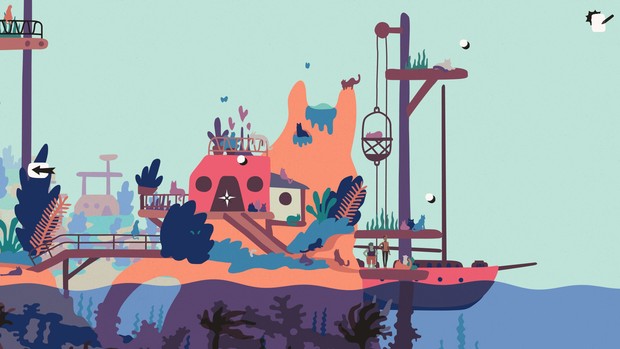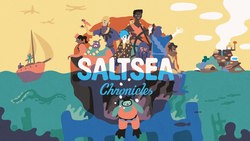Saltsea Chronicles review

- 0 Comments
Lovely interactive storybook is flooded with player choice but very little other gameplay
Saltsea Chronicles isn’t a “game” in the sense that there is a scoring system or a means to “win.” You can complete it, and there are optional gameplay elements to it, sure, but at its core the experience is more of a narrative creative endeavor with players participating in writing a story as they see fit instead of being challenged to overcome obstacles. The art style is charming, the setting unique and the characters diverse, but whether you can accept an experience devoid of all challenge or not is where your enjoyment will ultimately hinge.
The game takes place in a post-flood world where humanity occupies small pockets of dry land across a vast ocean. It’s not exactly Waterworld, though there are definitely conflict and tragedy to be found. The world is a much different place than it is for us, with a limited use of technology in day-to-day life. Trading of both goods and information is king here, and money has no real use. In fact, much about how the world used to work has been lost to time, and in its place new cultures and beliefs have arisen, with only legends and rumours as to what caused the great flood.
The story is centered around a group of characters including Iris, Murl, Molpe, Stew and Neshko, led by Maja, a dreamsailor who can see distorted visions of the future. Iris is the youngest and has a vested interest in old-world technology; Murl is a historian looking to travel and study the archipelago; Molpe is Maja’s partner and has a child; Stew is the group’s cook and central mother figure; and Neshko is a mysterious hermit who also happens to be a sound navigator. The game opens with the crew sitting around a fire one night on their home island as Maja entertains them with stories. Eventually the others go to sleep, leaving Maja alone at the fire, and by the next morning she has vanished without a trace. The group suspects foul play and sets out to find her, prompting them to hijack a craft named the De Kelpie and set sail towards strange lands.

Along the way other characters (may) join the group, and their inclusion (or exclusion, if you choose not to have them come aboard), can alter the story in interesting ways. However, it was hard for me to buy into the premise, or at least the characters, at the onset. Maja came off as egotistical and unlikable, despite her crew’s reverence for her, and the idea of embarking on an adventure to find her seemed wholly unappealing. Fortunately the central narrative weaves together in a rather satisfying way as you progress, and the ultimate conclusion is well-executed.
The world itself is nicely realized through art and writing. Aesthetically, Saltsea Chronicles is bright and cheerful, but not in a fairy-tale sense. The drama is real, and the hardships and choices faced by the crew carry genuine emotional weight. There is also a dichotomous thread of the mythical and scientific competing with each other throughout via dreamsailing and radio signals. The leads you choose to pursue usually hinge on one of these two foundations. The greater narrative is further revealed through the almanac, a collection of articles you can find across the game world. By engaging in conversation and points of interest you’ll unlock these articles, and you can spend a good amount of time researching the archipelago, though this is entirely optional.

Each chapter is a new stop for the De Kelpie, and your route through the archipelago is not linear, giving you the choice of where to go at several points. When sailing between islands, you’ll check in with the crew, having them interact (or not) in order to uncover or address outstanding issues. For instance, at one point Stew discovers that someone has been eating more than their allotted share. You can choose to ignore this situation altogether and the plot moves forward anyway. Or you can decide to have the guilty party interact with Stew, prompting a sort of side quest in the form of an unresolved narrative thread. With each opportunity to bring these characters together, you can converse and potentially resolve the conflict. Even if you don’t, though, the show goes on.
When you make landfall, the game assigns a primary character to disembark and explore the island but allows you to choose a companion to come along. Your reasons are your own: perhaps a companion speaks the native population’s dialect, revealing different plot points, or they could have an unresolved issue with the primary character, and the time spent together may help settle these issues. The many options mean there are an astounding number of alternate pathways and dialogues through the game, and the high volume of storytelling branches is an impressive accomplishment. Your progress is recorded automatically as you play, but the game encourages you to jump back into chapters as they are unlocked to uncover new routes of narration.
Saltsea Chronicles has two main modes of play. The first displays the world from a flattened landscape view, with the characters walking between hotspots highlighted on the screen. These points may trigger a descriptor or narrative bubble, or may prompt the crew members in the player’s control to start a conversation. These points of interest are all clearly highlighted by markers that indicate whether they are optional points to look at, conversations, a side activity, or a plot point to progress the game.
The second mode of play is traditional visual novel-style conversation, where characters stand on the right and left sides of the screen while the text of their conversation scrolls in the middle. Choices play out here, regarding not only an individual character’s verbal responses but how they act in relation to the current circumstances. You can choose, for example, whether someone will be direct or diplomatic in their questioning of an NPC, whether they show patience or anger, or whether the crew should let a new member join. It’s not that you’ll see less of the game if you play it a certain way, but rather just another side of the narrative. Regardless of whether you resolve conflicts, welcome new crewmates aboard, or trust one character’s intuition over another’s, there are no wrong choices in Saltsea Chronicles, just lots of viable options.

You can move the mouse about the islands/structures, clicking where you want your characters to go. The game can also be played with just a keyboard, using the arrows and other keys to leap between and enter/exit various points. Items can be collected and viewed in the main menu, though they are automatically used at their appropriate spot in the environment. Finding them is simply a matter of visiting every labelled key point on the main map in the primary mode of play, meaning it’s nearly impossible to find yourself stuck as to where to go next. The menu also keeps track of your current objective, as well as subplots involving different characters. The world almanac is found here as well and can be accessed at any time. Though I found myself referencing these menus quite a bit for the first two chapters, I quickly forgot they existed and simply played the game, making choices as I saw fit in the moment.
Even with no puzzles to solve, most of the game’s twelve chapters take between thirty to sixty minutes to complete, assuming you don’t partake in Spoils, the archipelago’s most popular card game. A sort of Go Fish-like game, Spoils is an optional activity you can frequently engage in if you like. Most settlements have their own variation on the rules that you’ll need to learn and master. However, Spoils, while a perfectly sound minigame diversion, wasn’t a draw for me, and thus I only played three rounds in my entire playthrough. There doesn’t appear to be any bonus content unlocked by winning these games, so I didn’t feel like I was missing out.
As with Mutazione, the developer’s previous game, Saltsea Chronicles utilizes a sort of flat collage animation, with the characters and settings constructed of rounded shapes arranged from cardboard paper-esque materials, albeit with the ability to move, warp, and animate more than actual paper would allow. It’s a pure, simple aesthetic, and every location is animated, with walking settlers, flocking birds, and rolling waves giving each place a sense of life and passing time. These visuals suit the game's relaxed vibe, as does the jazz jingle that plays during the game’s between-chapter segments.
There is little voice acting aside from the occasional single line, chuckle, or sigh, though the characters animate and express themselves so well through dialogue and body language that nothing is lost. The different fonts employed to convey dialects give the game a vivid visual language as well, and this synthesis of art and sound is truly effective if you take the time to stop and appreciate it.
The script is mostly well-written, though due to the sheer amount of text, it’s hard not to nitpick certain implementation issues, inconsequential as they may arguably be. Key information is sometimes unceremoniously shoehorned in as a side note when explaining how someone feels, or when introducing a new character, when perhaps it would have been better communicated more organically through dialogue. When a surprise character is introduced in the fifth chapter, I actually thought I had missed something, or the game had jumped ahead, due to the awkward and anticlimactic nature of their sudden addition. Such instances don’t exactly bring the game to a screeching halt, but they occur frequently enough to break the otherwise immersive narrative that it’s worth noting.
Final Verdict
As rich as Saltsea Chronicles is in artistry, I found it hard to muster much interest in the characters themselves. I tried to keep consistent with individual mood choices, and I chased new narrative threads whenever I could over the course of six or so hours, but ultimately the lack of gameplay led to a corresponding lack of engagement. Even with the ease of play and gentle pace – or perhaps because of them – I found it hard to get excited. For long stretches I simply went through the motions, and so little happened that it was hard to play for more than an hour or a chapter at a time. That’s not to say the game needs a more robust or involved system for managing character interaction or the ship’s navigation, but … well, it would have been kind of fun if it had? If all you’re really looking for is an interactive story with player agency over character relationships, there’s more than enough here for multiple playthroughs. However, there’s no getting around the fact that there’s just not much game here, and thus not much to grab hold of you. The addition of exploratory segments makes it more than a pure visual novel, but anyone looking for more hands-on engagement than a storybook brought to life, however pretty it may be, may find it tempting to disembark before the De Kelpie reaches her destination.
Hot take
Even with a bit of open exploration, Saltsea Chronicles is essentially a visual novel – a character-driven, story you read on screens of charmingly beautiful backgrounds. It’s a stress-free piece of interactive media that invites players to help write the unfolding tale, but those looking for deeper gameplay won’t find any swashbuckling, seafaring action in these calm seas.
Pros
- Thoughtful aesthetic in everything from fonts to character and environmental design
- Satisfying narrative arc and ultimate conclusion
- Many routes through, with the ability to restart from any chapter encouraging replay
Cons
- Aside from the card minigame and searching for not-so-hidden almanac articles, the experience is devoid of any challenge
- Key information is sometimes shoehorned in
Drew played Saltsea Chronicles on PC using a review code provided by the game's publisher.











0 Comments
Want to join the discussion? Leave a comment as guest, sign in or register.
Leave a comment